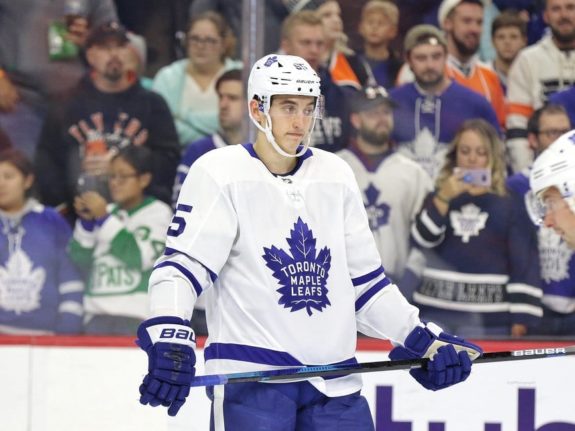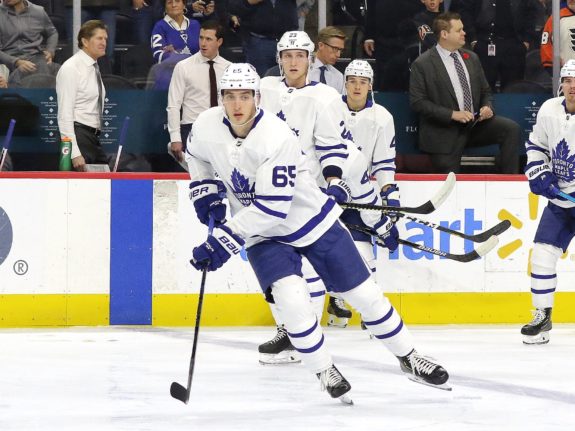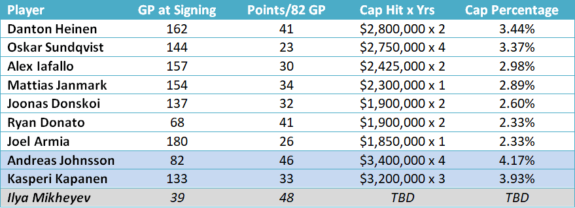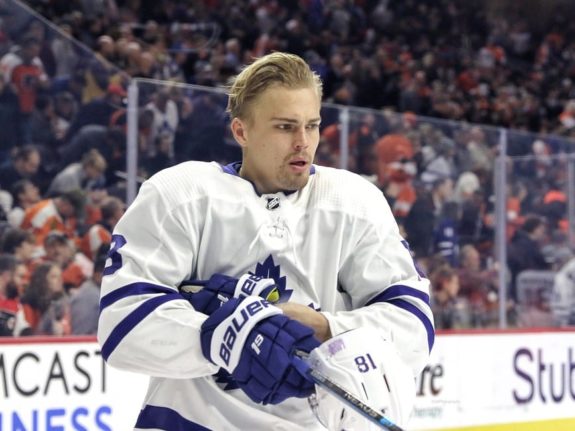
 Chris Faria
The Hockey Writers
Chris Faria
The Hockey Writers
38
Reads
0
Comments
Should the Maple Leafs Bet Big on Ilya Mikheyev?
Last spring, Ilya Mikheyev was a relative unknown in the hockey world outside of Russia. The then 24-year-old winger had just scored a team-leading 23 goals and 45 points for Avangard Omsk of the Kontinental Hockey League before declaring his intention to make the move to the NHL. By April there were rumblings of his interest in the Toronto Maple Leafs, and in May he made it official by signing a one-year entry-level contract with the team.
But even with his impressive resume over in Russia, there were still many lingering questions about Mikheyev’s potential in a tougher league, on a smaller ice surface. Would he have the quickness and mental acuity to make decisions that much faster? Would he be able to stand up to the more physical North American game? Would his production translate?

After all, at that time we were just a year removed from the Vegas Golden Knights’ failed experiment with KHL star Vadim Shipachyov, who had tallied 76 points in 50 games the season prior. Sin City proved to be a poor fit for Shipachyov as he packed up and headed home after a mere three-game tryout. Needless to say, there had to be similar doubts about Mikheyev’s foray into a foreign league.
But unlike his countryman, Mikheyev’s transition to the NHL was basically seamless. In fact, the 6-foot-3 winger probably outperformed expectations before his unfortunate season-ending injury in December. Through 39 games, he posted 8 goals and 23 points while serving as a key cog on the team’s penalty kill, and he seemed to be getting more comfortable by the game.
Related: What the Toronto Maple Leafs Can Expect from Ilya Mikheyev
The question, then, is not whether the Maple Leafs should extend Mikheyev, but just how big of a bet they should make after seeing less than half a season of work.
Mikheyev’s Value Is Understated
If we extrapolate over an entire 82-game season, Mikheyev would have finished the year with 17 goals and 48 points – solid but certainly not staggering numbers, and it’s difficult to put a lot of faith in a relatively small sample size. Looking beyond the basic counting stats, though, it becomes clear that Mikheyev provided even more value than his point totals would suggest.

Given that he virtually never touched the ice on the power play (he averaged just six seconds per game), Mikheyev’s production is that much more impressive. In fact, he actually led the Maple Leafs in points-per-hour at five-on-five at 2.44 – besting star teammates Auston Matthews (2.34), William Nylander (2.32), Mitch Marner (2.17), and John Tavares (1.8). On a league-wide scale, that scoring pace placed Mikheyev at 34th among forwards, just behind household names like J.T. Miller, Jonathan Huberdeau, and Mark Stone. Needless to say, the Maple Leafs winger was having an extremely productive season and arguably never received enough praise for his offensive touch.
Related: All-Decade NHL Draft – 2010 to 2019
On the defensive side, Mikheyev emerged as an integral part of the Maple Leafs’ penalty kill where he was the team’s second-most used forward (1:55 per game) behind only Marner (2:13 per game), though the Russian had far better on-ice results.

Once you compare Mikheyev to the rest of the team’s regular penalty killers, it becomes clear just how much he (and Pierre Engvall) stood above the pack this season. Although the hulking winger did create his fair share of shorthanded chances, where he really shined was in limiting shots and goals for opposing power plays. And while killing penalties isn’t necessarily sexy, it undeniably adds even more value to a player that already scores at an exceptional rate.
Who Are Mikheyev’s Contract Comparables?
Perhaps the trickiest thing about analyzing Mikheyev is not figuring out his on-ice value, but rather finding players around the league that are actually comparable. The main issue is that we have a mere 39-game sample size for the Maple Leafs forward, while most restricted free agents (RFAs) get at least a full season or two years of NHL experience under their belts before signing an extension. Nevertheless, let’s take a look at some RFA deals that may influence Mikheyev’s next contract with Toronto.

Looking around the league, you can get a general sense for how much Mikheyev will likely cost on his next deal and frankly, it’s not looking great for the cash strapped Maple Leafs.
The absolute cheapest comparable would probably be Ryan Donato, who signed for $1.9 million with the Minnesota Wild prior to 2019-20 after being traded from the Boston Bruins. His resume was also quite limited at the time of his signing, which makes him the most similar to Mikheyev in that regard. On the other hand, you’ve got someone like Danton Heinen who signed for nearly a million more with the Bruins in 2019 after averaging the same scoring pace as Donato.
I threw some Maple Leafs players in for reference as well because they might be the players that Mikheyev and his agent point to as most relevant. It also helps Mikheyev’s camp that Kapanen and Andreas Johnsson also happen to be the two highest-paid players of the above contingent – a common theme for general manager Kyle Dubas who has sometimes struggled to keep his players’ salaries low.

The main trend you will notice among all of these players is that their contract lengths are quite short at one to three years. Johnsson and Oskar Sundqvist’s four-year deals look like the outliers in that regard, although I personally tend to like the slightly longer-term deals, assuming you’re confident in the player’s abilities.
Related: Fuzzy History of the NHL Playoff Beard
Given what we know about Mikheyev’s production and on-ice value, his comparables around the league, and the comparable contracts on Toronto’s roster, it looks like he should fall somewhere around four percent of the salary cap on a one to four-year deal. The contract length, of course, will depend on how comfortable the Maple Leafs’ front office is with their assessment of the player (are they convinced he’s that good after just half a season?), and the cap hit will then slide up or down along with it.

If I had to put a number on it, I’d guess that he signs either a one-year “show me” deal for around $2.5 million, or a three to four year deal at $3.5 million. I think Mikheyev is a terrific and versatile player – probably better than both Johnsson and Kapanen – but he just hasn’t shown enough yet to earn significantly more than them. And that’s why it may make sense for him to sign short-term and gamble on himself.
All things considered, I don’t think the Mikheyev negotiation is going to be a particularly easy one for the Maple Leafs. For starters, it’s hard to know exactly what the player is at this point, and Toronto’s front office will be leery of making another rash decision as the old guard did with fellow Russian import Nikita Zaitsev. Things will be further complicated by the COVID-19 pandemic and the questions it raises about the future of the NHL, the league’s salary cap, and what the 2020-21 season will look like – if it happens at all.
The post Should the Maple Leafs Bet Big on Ilya Mikheyev? appeared first on The Hockey Writers.
Popular Articles

















































 Blackhawks Chicago
Blackhawks Chicago Panthers Florida
Panthers Florida Penguins Pittsburgh
Penguins Pittsburgh Rangers New York
Rangers New York Avalanche Colorado
Avalanche Colorado Kings Los Angeles
Kings Los Angeles Maple Leafs Toronto
Maple Leafs Toronto Bruins Boston
Bruins Boston Capitals Washington
Capitals Washington Flames Calgary
Flames Calgary Oilers Edmonton
Oilers Edmonton Golden Knights Vegas
Golden Knights Vegas Senators Ottawa
Senators Ottawa Lightning Tampa Bay
Lightning Tampa Bay Flyers Philadelphia
Flyers Philadelphia Islanders New York
Islanders New York Sabres Buffalo
Sabres Buffalo Red Wings Detroit
Red Wings Detroit Devils New Jersey
Devils New Jersey Hurricanes Carolina
Hurricanes Carolina Blue Jackets Columbus
Blue Jackets Columbus Predators Nashville
Predators Nashville Stars Dallas
Stars Dallas Jets Winnipeg
Jets Winnipeg Wild Minnesota
Wild Minnesota Blues St. Louis
Blues St. Louis Mammoth Utah
Mammoth Utah Sharks San Jose
Sharks San Jose Ducks Anaheim
Ducks Anaheim Canucks Vancouver
Canucks Vancouver






